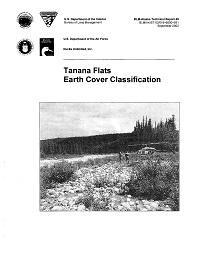Tanana Flats Earth Cover Classification

The Department of the Interior has established the Research and Monitoring Committee to identify research, monitoring, and inventories that must be accomplished to establish short and long-term mitigation for Military Operational Areas (MOAs) in Alaska. The establishment of base-Ievel land cover information is key to any terrestrial research project. Therefore, the United States Air Force has contracted with the Bureau of Land Management (BLM) to map approximately six million acres within designated MOAs in Alaska, including important waterfowl habitats. This data will ultimately be used to assess satellite imagery for mitigating the potential impacts of military overflights on the Delta caribou herd. The cooperators in this project include BLM-Alaska, Ducks Unlimited, Inc., and Pacific Meridian Resources.
One Landsat Thematic Mapper (TM) satellite scene (Path 68/Row 15, shifted 23% south, acquired July 14, 1993) was used to classify the project area into landcover categories. Fifty five, 1:63,360 scale, quadrangle color infrared plots of the Landsat TM data were produced for the placement of field sample sites and for navigational purposes with the helicopters. A custom field data collection card was used to record field information. After initial on-the-ground sampling, a helicopter was utilized to gain access to field sites throughout the project area. Global positioning system technology was used to record locations of sites sampled in the field. Data was collected on 315 field sites during a five-day span in late August 1995. A portion (30%) of these field sites were set aside for accuracy assessment.
A modified supervised/unsupervised technique was used to classify the satellite imagery. Digital elevation models were used to stratify the project area into the alpine tundra class and to alleviate most of the shadow effects from mountains. The results of this classification indicate low shrub is the dominant landcover in this region accounting for 20.2% of the project area. The percentages for the rest of the landcover types are: other (clouds, cloud shadows, etc.) 15.4%, open needle leaf forest 14.90/0, closed mixed forest 6.3%, closed deciduous forest 5.7%, snow 5.0%, closed needle leaf forest 4.9%, tall shrub 4.2%, dwarf shrub 3.8%, graminoid 3.70/0, alpine tundra shrub 2.80/0, alpine tundra graminoid 2.5%, sparse vegetation 2.0%, bryoid/lichen 1.8%, open deciduous forest 1.6%, agriculture 1.3%, ice 1.2%, clear water 1.0%, turbid water 0.90/0, wet herbaceous 0.4%, urban 0.3%, and aquatic bed 0.1 %. The overall accuracy for the classification was 82%. This geographic information system database will be used to model the impacts of low-altitude jet aircraft flyovers on wildlife within the MOAs of Alaska's interior.
